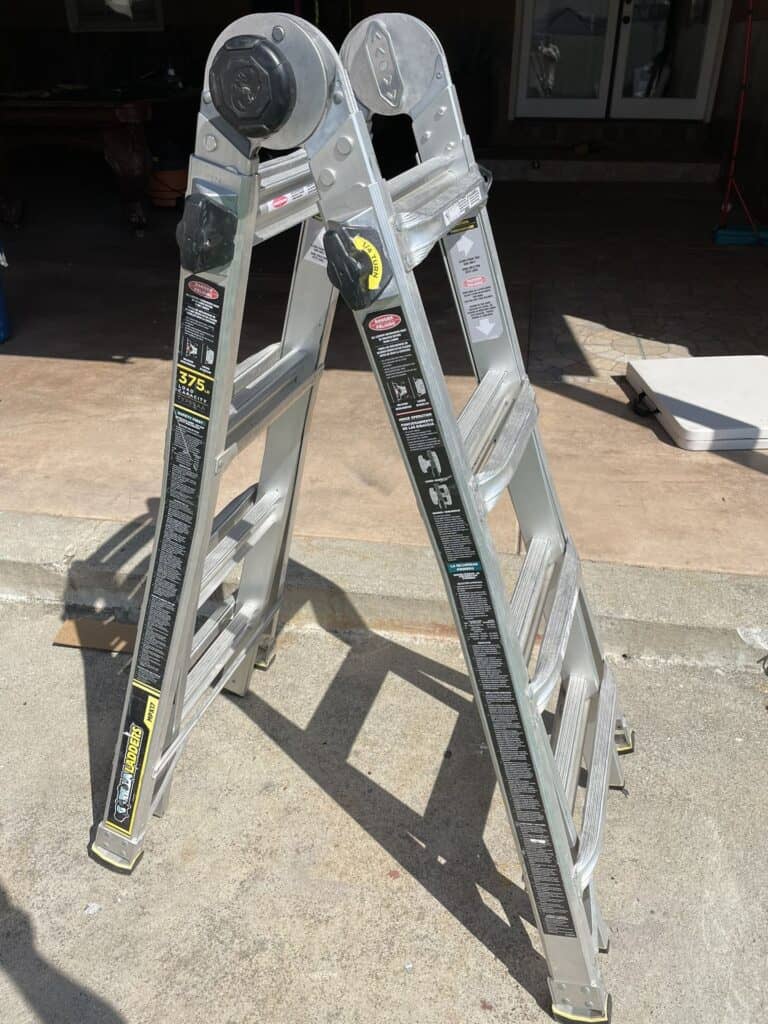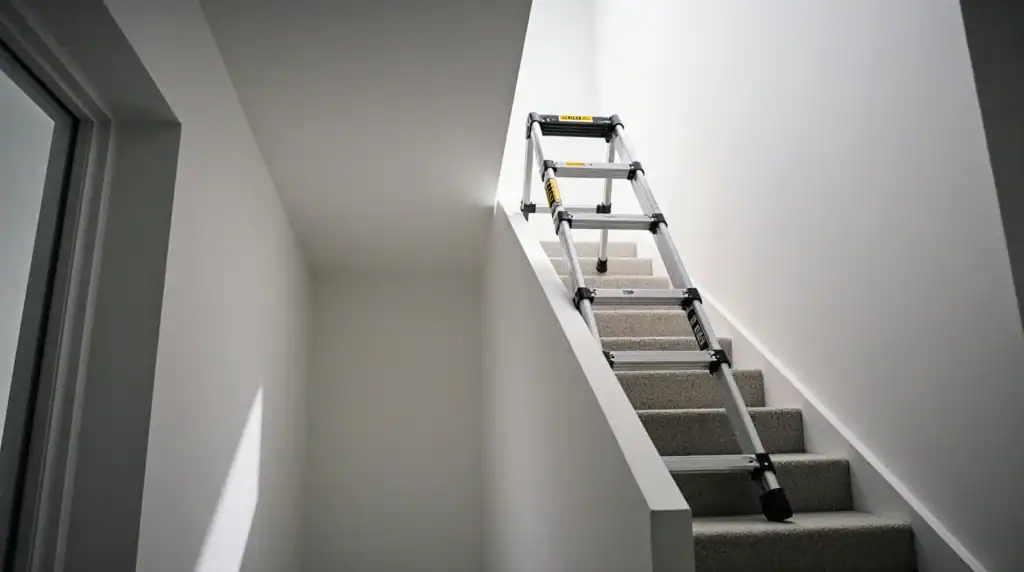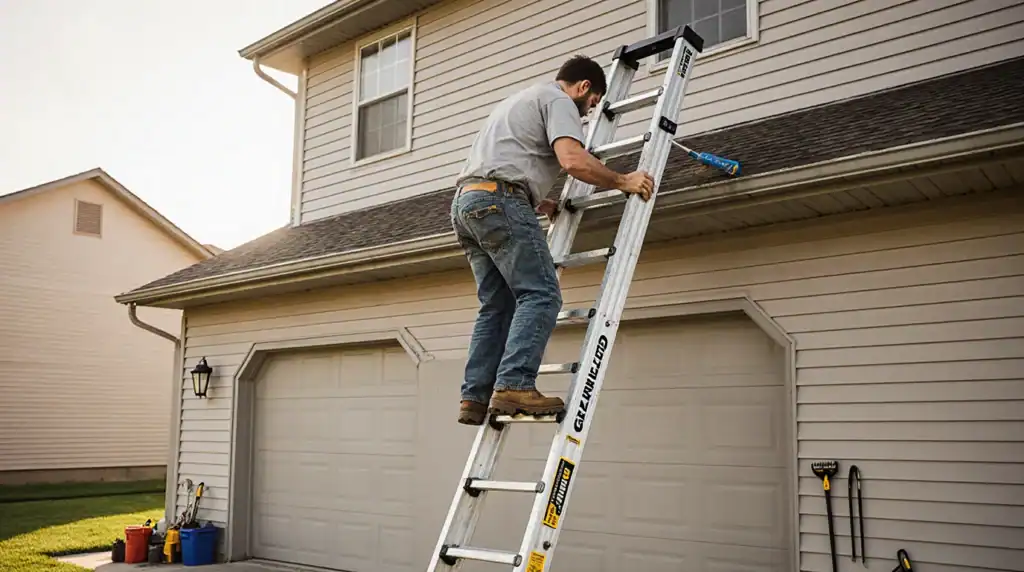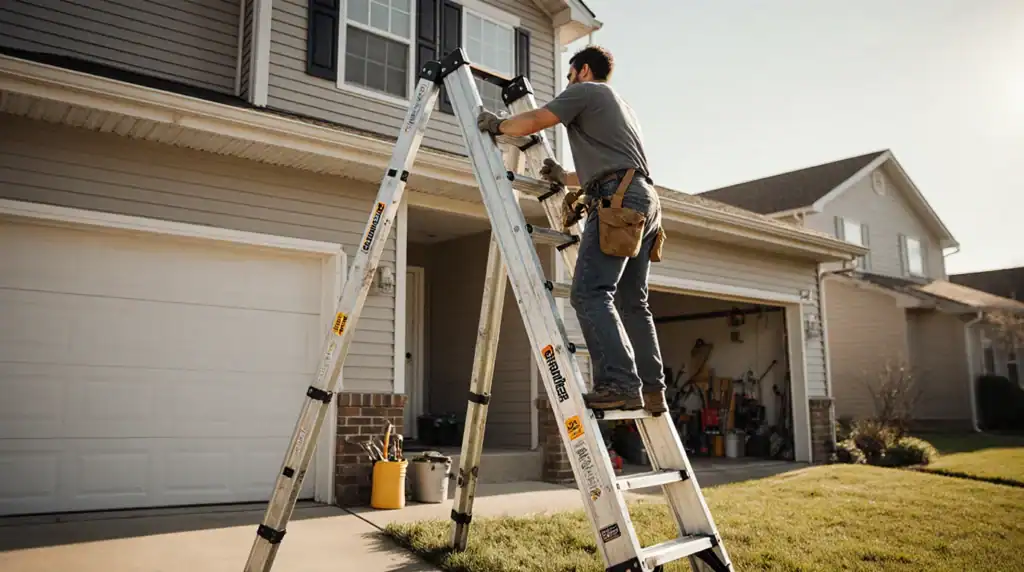You know the moment. You’re walking through The Home Depot and you see the wall of ladders. You’ve got that wobbly old 6-foot aluminum thing sitting in your garage. Then you see the Gorilla Ladder. It looks like something out of a robot movie—a Transformer—and it promises to be roughly 18 ladders wrapped into one.
The marketing is slick: it suggests this is the only ladder you’ll ever need. But if you’re like most pros or serious DIYers, you’re standing there thinking, “Is this thing a gimmick? Is it going to be a 40-pound monster I regret buying?“.
I’ve owned one, and I’ve used it for everything you can think of, from cleaning two-story gutters to hanging a picture in a stairwell. Here is the straight-up, no-fluff breakdown of whether the Gorilla is right for you.
The Quick Specs (What I’m Working With)

For reference, I’m talking about the Gorilla MPX17—the 18-ft multi-position aluminum model that comes in around 38 pounds. The features are generally similar across the Gorilla multi-position line, but the weight is the spec that matters most.
Here is what you need to know about the MPX line:
-
- Max Reach: 18 ft. This is the maximum reach as an extension ladder, so don’t confuse it with its A-frame height. The Multi-Position ladders are available in size variations up to 26 ft.
- Weight: ~38 lbs. Trust me, this is the most important spec to pay attention to.
- Load Capacity: 300 lbs (Type IA). That just means it’s rated for heavy-duty, professional use, so it’s not going to feel flimsy.
- Material: Aluminum. Gorilla also makes fiberglass models, but they tend to be even heavier.
- Main Positions: The adjustable hinges allow the ladder to be used in four configurations: A-Frame (Twin Stepladder), Extension, Staircase (Stairway), and 90-Degree wall ladder.
Also read: Best Hammer Drill
The Good Stuff (Why I Genuinely Like Mine)

It Replaces a Truckload of Ladders
Seriously, this is the main pro. I used to have a 6-ft A-frame, a 16-ft extension, and a small step stool taking up half my garage. The multi-position Gorilla actually replaces all those.
I used mine as an A-frame to install a ceiling fan in a 10-ft ceiling. An hour later, I unfolded it to its full extension to re-attach a piece of siding that had blown off the second story. One tool, two totally different jobs.
The “Stairwell” Feature is Worth the Price Alone
This is the “killer app”. You know how impossible it is to paint a high wall above a staircase? Trying to do that job with 2x4s and a regular ladder is just asking to get hurt.
With a Gorilla, you just shorten one side and extend the other (the Stairway configuration). It sits perfectly stable, with one foot securely placed on the stairs and the other on the landing. Little Giant ladders offer a similar feature with ratcheting levelers for uneven ground.
It’s a Tank (In a Good Way)
It’s a misconception that a ladder has to be crazy expensive or weigh a ton to be stable. Gorilla found a good balance here. They feature flared legs (a wide base) and durable, oversized MPX hinges that decrease flexing or swaying when you climb. The wide base makes it feel way more stable than a standard, skinny extension ladder. When I’m 15 feet up, I feel a lot less wobble. That confidence is huge. I can confirm this thing is solid. It’s extremely stout when used as a stepladder.
Also read: Best Heat Guns
The Bad Stuff (What Drives Me Nuts)
Let’s Be Honest: It. Is. HEAVY.
Don’t let anyone tell you otherwise. My 18-ft model is 38 pounds. That’s a lot heavier than a simple stepladder or a basic extension ladder.
Moving it from the garage to the driveway is no big deal. But when you have to carry it through the house, up the stairs, and around a tight corner? It’s awful. It’s bulky and cumbersome. If you just want to change a recessed lightbulb inside, you will 100% grab a kitchen chair instead of hauling this thing out.
Those “Easy-Use” Hinges Will Get You
The ladder uses spring-loaded locks (or “speed locks”) to quickly adjust the height and rail locks that require a 1/4 turn. They work, but it’s not a delicate, one-handed operation.
To unlock the hinge, you must press the palm button. You have to pull or push the ladder hard, and it snaps into place when locking. Here’s a tip: If the hinge feels stuck, it’s because it’s ‘bound up’ with pressure. You can’t just force it. You have to wiggle the ladder section back and forth a bit to ‘un-pinch’ the lock, and then it’ll disengage easily. I’ve pinched my fingers hard more than once. It’s loud, chunky, and requires deliberate action.
It’s Overkill for 90% of Indoor Jobs
Hanging a picture or reaching the top pantry shelf? It’s like using a sledgehammer to tap in a thumbtack. It’s simply too big, too heavy, and too much fuss for little tasks. The ladder also has a large footprint, which can be challenging if you need to get into tight spaces.
Also read: Best Safety Glasses
So, Who Should Actually Buy One?

The Gorilla ladder is an excellent buy if you only plan to own one ladder.
You’ll LOVE it if:
- You are a homeowner with a 1.5 or 2-story house.
- You have high ceilings, a foyer, or a stairwell that needs painting or cleaning.
- You plan to clean your own gutters.
- You have limited garage space and need one versatile ladder that does it all.
You should probably PASS if:
- You live in an apartment or a small, one-story house.
- You primarily do small indoor repairs.
- You have trouble lifting 40 pounds easily. I’m not kidding, the weight is a real factor.
The Alternative: If you fall into the “pass” category, just buy a high-quality 4-foot or 6-foot fiberglass step ladder. You’ll be much happier.
My Top Tips (After Pinching My Fingers Too Many Times)
The Pinch-Proof Grip
When changing the hinge position, put your palm flat on the lock button and push. Keep your other hand strictly on the side of the ladder rail, not wrapped around it near the hinge. Even with the ‘pinch-proof’ design, you can (and will) pinch your fingers if you’re not paying attention.
The “Walk-Up” Trick (Extension Mode)
When using it as an extension ladder, do not try to fully extend it on the ground and then raise it—it is too top-heavy. Instead, set it up as a tall A-frame, “walk” it up against the house, and then undo the rail locks to slide the final section up. For stability, remember the 4-to-1 rule: For every 4 feet you go up, the base of the ladder should be 1 foot away from the wall.
Listen for the “CLICK”
Always, always wiggle the ladder and visually check that both side rail locks and hinges are fully engaged before you put a foot on the first rung. The rail locks are fully locked when no red is showing. Don’t ever, ever climb it until you’ve checked. That’s how people get seriously hurt.
The Accessory That’s Worth It
- Skip: The little clip-on “project tray.” It’s often flimsy. (Though Gorilla offers a removable project bucket accessory, Model# GLMP-BKT, priced at $23.99).
- Buy: The “Step Platform”. This is a metal step you slide in between the rungs when the ladder is in A-frame mode. This step platform (Model# GLMP-PLTFM, $58.00) saves your feet and shins if you have to stand on the ladder for more than 10 minutes.
Also read: Cattle Prod
The Final Verdict: Is It Worth the Money?
A Gorilla Ladder is not just a ladder; it’s a problem-solving tool.
It is the wrong choice for simple, everyday tasks because it’s too heavy and clunky for that.
But for those big, awkward, or high-up jobs that happen a few times a year—painting the stairwell, clearing the roof, hanging Christmas lights—it is one of the most versatile and secure-feeling tools you can own.
My final advice: If you just need to reach a high shelf, get a step stool. If you need to safely solve a problem on a 15-foot wall, yeah, it’s worth the money and the muscle. If you want a more budget-friendly option compared to brands like Little Giant, Gorilla Ladders suit you best.








1 thought on “Thinking About a Gorilla Ladder? Here’s the Honest Truth.”